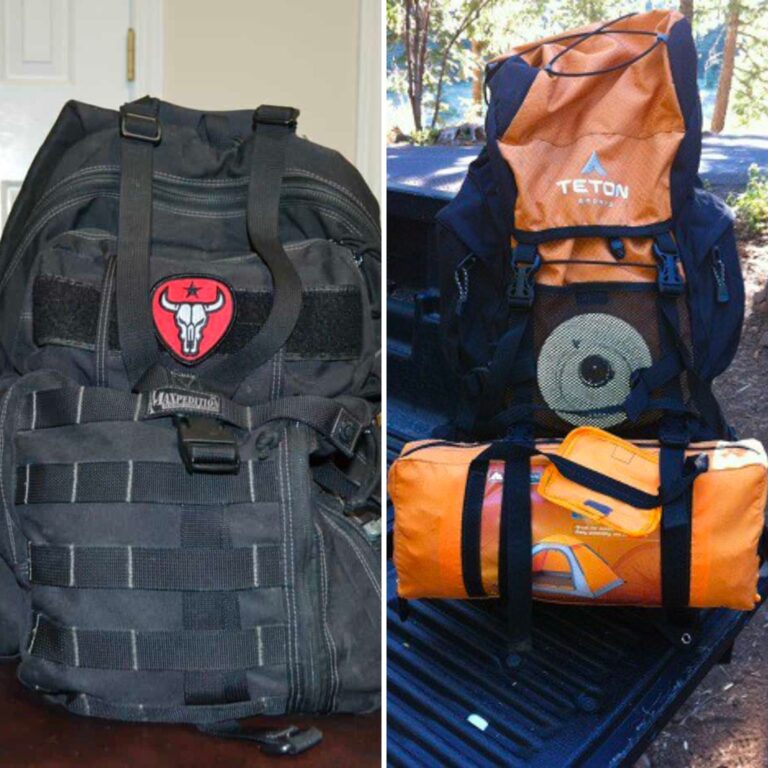
When it comes to choosing a backpack for your outdoor adventures, whether it's hiking, camping, or any other activity, the options can be overwhelming. There are a wide variety of backpacks available, including military-style tactical packs, hiking packs, and hybrids of the two. But what are the actual differences between tactical and hiking backpacks? And which one is right for you?
Tactical vs. Hiking Backpacks: An Overview
In general, hiking backpacks are designed with a focus on lightweight materials, waterproofing, visibility, and user comfort. On the other hand, tactical packs prioritize expansion capability, low-profile colors, durability, and carrying capacity.
While this is a simplified explanation, it's important to understand the nuances that set these two types of backpacks apart. The right choice for you will depend on your preferences and specific needs.
The Importance of Choosing the Right Backpack
It's easy to assume that all backpacks are the same, but this couldn't be further from the truth. Choosing the wrong backpack can result in a lack of storage space, discomfort, and other issues such as breakage or inadequate visibility.
That's why it's crucial to assess both tactical and hiking backpacks based on their individual merits. By understanding the key differences, you can make an informed decision and find the backpack that best suits your needs.
Weight and Material: The Differentiators
When comparing tactical and hiking backpacks of equal size, one of the most noticeable differences is the weight and material used for construction. Hiking backpacks are typically made of lighter synthetic materials, prioritizing weight reduction. In contrast, tactical packs are constructed from thicker, more durable materials like 1000d or 500d ballistic nylon weave, ensuring enhanced durability and resistance to wear and tear.
While hiking backpacks can still be durable and well-constructed, the lighter materials they use make them more susceptible to punctures and tears. This reflects the fact that hiking backpacks are not subjected to the same level of extreme conditions as tactical packs, which are often used in conflict zones.
Carrying Capacity: Tactical Packs vs. Hiking Packs
Carrying capacity is another crucial aspect to consider. Tactical packs are specifically designed to handle heavier loads, emphasizing their carrying capabilities. These packs are built to be loaded to their maximum capacity and can withstand the weight without compromising their integrity.

On the other hand, hiking packs tend to prioritize efficient weight distribution and discourage overpacking. They typically have one large main compartment, allowing users to pack their belongings securely and comfortably. While seasoned hikers may prefer to travel light, there are situations where a tactical pack's ability to carry heavy loads becomes advantageous.
Colors and Visibility: Tactical vs. Hiking Packs
One of the most apparent differences between tactical and hiking packs is their color schemes. Tactical packs are designed to blend in and avoid drawing attention, often coming in low-profile colors or camouflage patterns. In contrast, hiking packs come in a wide range of colors, including bright and vibrant options.
The choice of color reflects the intended purpose of the backpack. Tactical packs aim to keep the carrier inconspicuous, especially in situations where being spotted could pose a threat. Hiking packs, on the other hand, may use bright colors to enhance visibility, making it easier to locate and potentially receive help or rescue in emergency situations.
Attachment Points and Storage Compartments
When it comes to attachment points and storage compartments, tactical packs and hiking packs differ in their design. Tactical packs are often equipped with extensive PALs or MOLLE webbing, along with various loops, straps, and openings for attaching additional pouches and gear. This allows for greater adaptability and customization, catering to specific mission requirements.
While hiking packs may feature a few attachment points, they generally prioritize internal storage and organization. Hiking packs often have a single large main compartment and possibly a small inner pouch or lid for smaller items. This design philosophy aims to ensure efficient and secure packing for a comfortable hiking experience.
Waterproofing: A Focus for Hiking Packs
Both tactical and hiking packs offer some level of water resistance or waterproofing. However, hiking packs tend to place more emphasis on this feature. Many hiking packs are constructed using materials that are partially or completely waterproof or designed to repel water effectively.
Tactical packs, on the other hand, are often made from thick nylon fabrics that can readily absorb water. This is because tactical packs are primarily used in situations where the user cannot stop or avoid inclement weather. The need for weatherproof gear is critical to ensure mission success.
While some hiking packs may feature integrated rain covers or offer additional waterproofing measures, it's important to check the manufacturer's specifications and test the pack's waterproof capabilities before relying on it in wet conditions.
Understanding the differences between tactical and hiking backpacks allows you to make an informed decision based on your specific needs and preferences. Whether you prioritize durability, weight reduction, carrying capacity, or other factors, choosing the right backpack is essential for a successful outdoor adventure.
—————————————————————————————————————————————————————————————–
By: Tim Makay
Title: Tactical vs. Hiking Backpacks: Understanding the Key Differences
Sourced From: modernsurvivalonline.com/tactical-vs-hiking-backpacks/
Published Date: Mon, 18 Sep 2023 13:30:00 +0000

